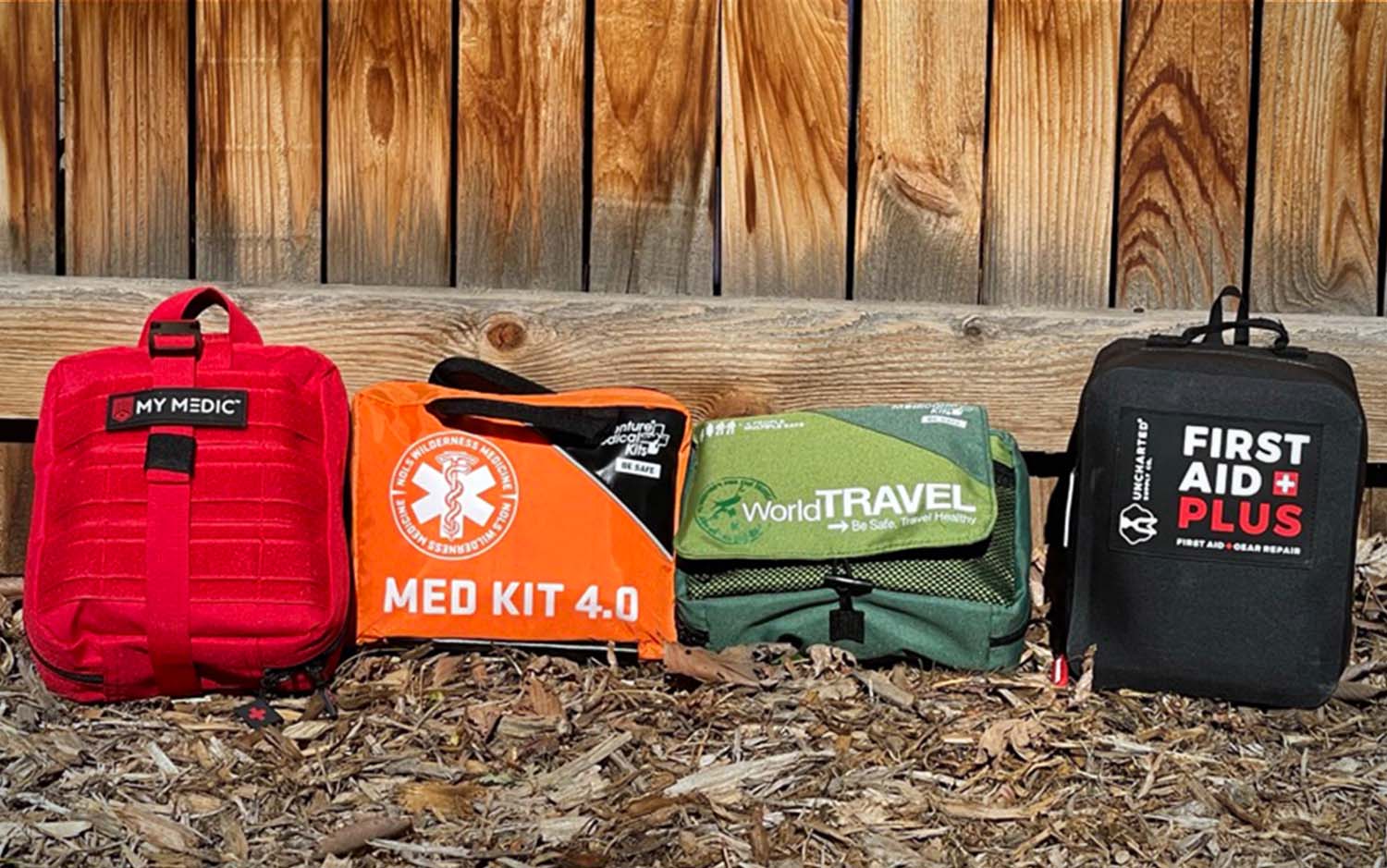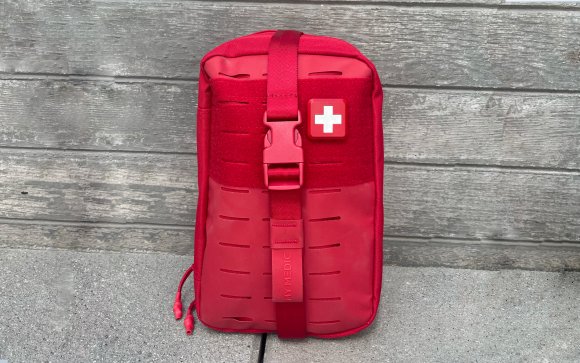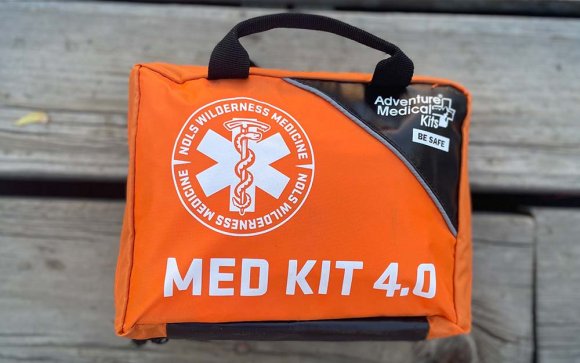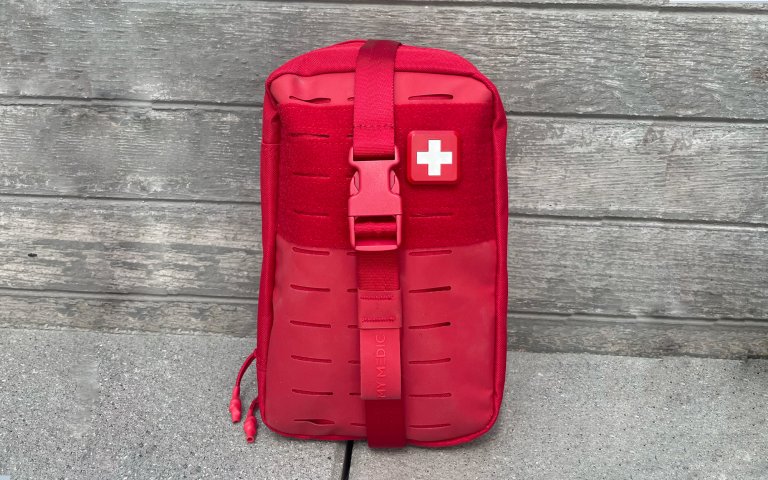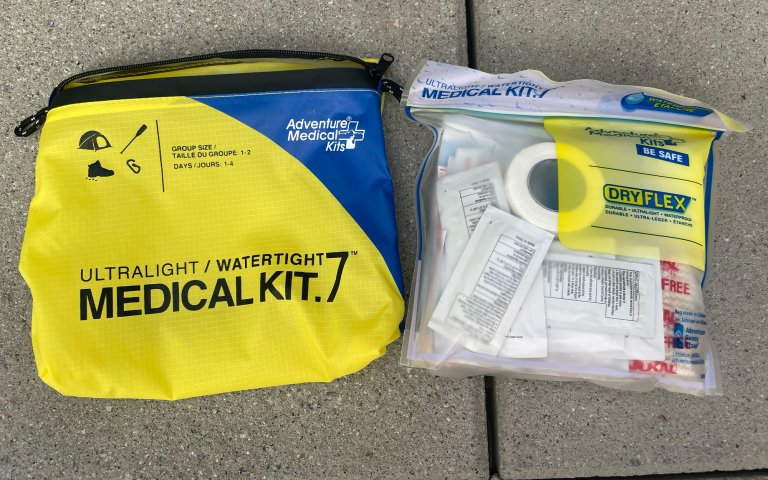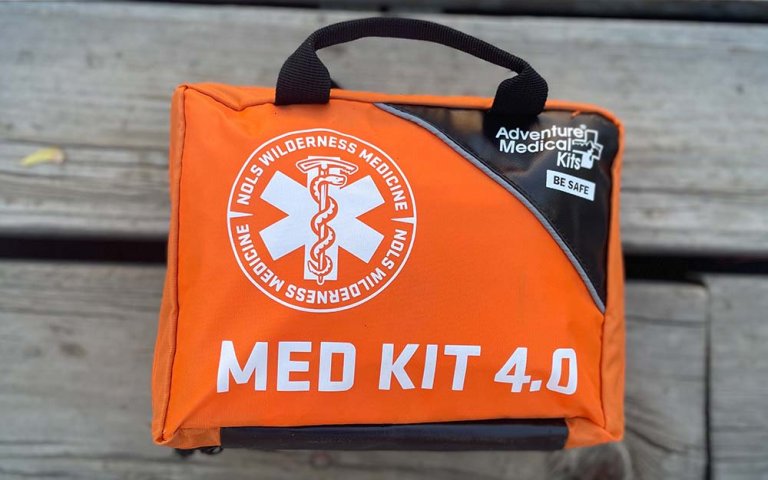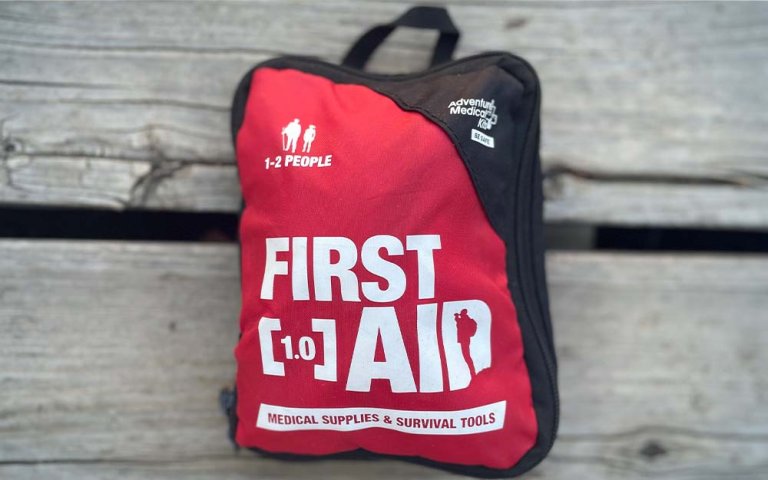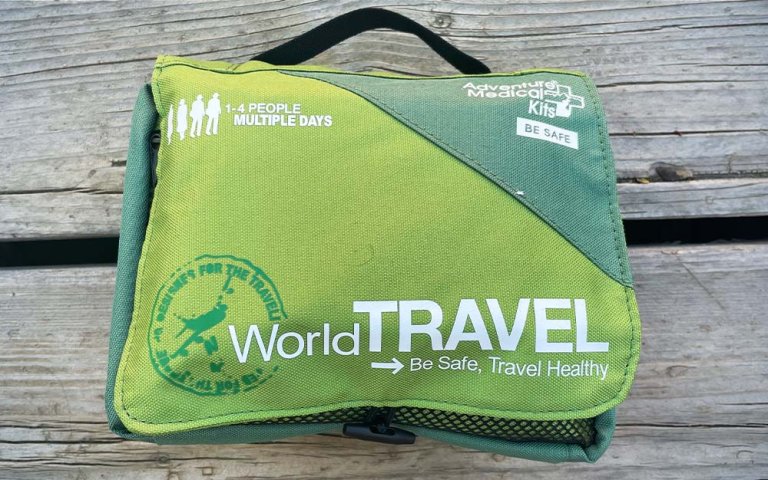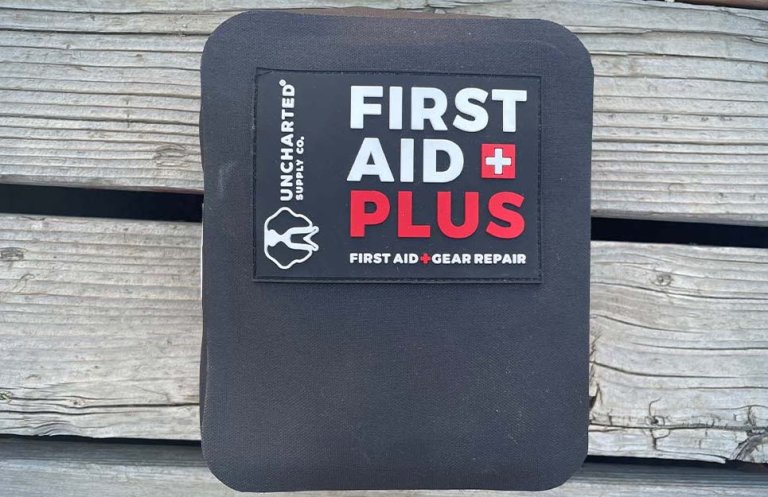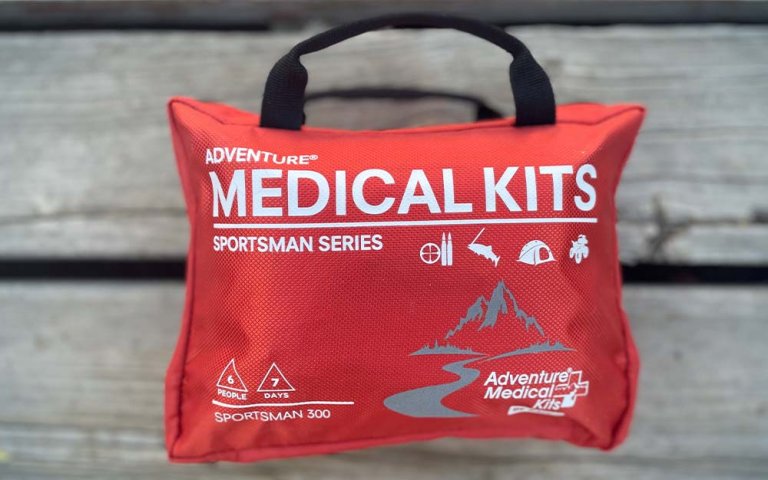We may earn revenue from the products available on this page and participate in affiliate programs. Learn More ›
Cuts, twisted ankles, and … much worse happens. Part of being an outdoors person is being prepared for the worst, and being able to tackle minor problems before they turn into big ones. On top of knowing your route and packing enough food, water, and layers, having the best first aid kit for your trip is a critical part of getting outside.
When (not if) your next medical issue comes up — whether that’s a small cut or a major evacuation — you need to be prepared with the right emergency supplies to either finish out your trip or stabilize and get someone to care safely.
As a former outdoor educator with a NOLS Wilderness First Responder certification, I evaluated the below emergency kits for different scenarios, and interviewed medical professionals in the industry for their first aid recommendations.
- Best Overall: My Medic MyFAK
- Best Lightweight: Adventure Medical Kits Ultralight / Watertight Medical Kit .7
- Best for Hiking: NOLS Med Kit 4.0
- Best Basic: Adventure Medical Adventure First Aid 1.0
- Best for Travel: Adventure Medical Kits World Travel
- Best for Car Camping: Uncharted Supply Co. First Aid Plus, First Aid + Gear Repair
- Best for Hunters and Anglers: Adventure Medical Kits Sportsman Series
- Best for Dogs: My Medic Pet Medic Med Pack
How I Chose the Best First Aid Kits
For this article, I tested 13 medical kits by first grouping them into three categories: access to home/car, day trip, and one or more nights. These categories take into account weight and how long it would take a patient to get to professional care. If you have access to your home or car, the MyFAK and First Aid Plus had the most extensive range of supplies, and were also packable.
For the day trip and overnight categories, I ran through a series of NOLS scenarios, and evaluated how well I could treat the patient based on the supplies in front of me. For more specific kits, like the World Travel and Pet Medic, I compared them to similar kits on the market and considered their packability, supplies, and unique features.
While you’re pretty much guaranteed to spend a decent amount on a quality kit, there were some kits I tested whose price did not match their quality or amount or range of materials. If I could find a similar product for significantly cheaper, it was immediately ineligible for an award.
Best First Aid Kits: Reviews & Recommendations
Best Overall: My Medic MyFAK
Pros
- Comprehensive first aid kit with basic first aid, survival, and intensive wilderness medicine supplies
- The Pro includes intensive backcountry first aid materials like a tourniquet, chest seals, bleed kits, and nasopharyngeal airway devices (NPAs)
- Kit is organized by medical category
- Ample supply of single-use supplies like medications, bandages, and wipes
Cons
- At $170 for a Standard and $330 for a Pro, it’s a steep price if you don’t know how to use (or see yourself needing) all the supplies
- SAM Split should be included for this price
- No way to shrink or pack down for backpacking-appropriate size
Key Features
- Weight: 2 pounds, 6 ounces (Standard) or 3 pounds, 5 ounces (Pro)
- Supplies for bleeds, burns, sprains, fractures, and hydration, including survival tools and over-the-counter medications
- Folding design with 10 mesh pockets
- Online M.A.R.C.H (Massive bleeding, Airway, Respiration, Circulation, Hypothermia) training course included with purchase
The MyMedic MyFAK is the most comprehensive and durable first aid kit on this list. It tackles close to any medical issue you will encounter as an outdoorsperson, from burns to fractures. This kit is heavy, but it is still great to have on-hand if you aren’t walking in too far to hunt, fish, or climb, for example. The weight is worth having ready if something were to go wrong.

What separates the MyMedic MyFAK above the rest is their thoughtfulness and commitment to provide all supplies for those “what if” situations you hopefully only encounter in a classroom. It’s hard to wrap your head around paying $330 for the Pro, but you’re not paying for individually-wrapped ibuprofen. You’re paying for two chest seals, two nasopharyngeal air devices, and hemostatic dressing — individually wrapped and, hopefully, never restocked. These are the kinds of kits that you cannot make at home.
As an avid backpacker, I consistently shop from this first aid kit before hitting the trail because the MyMedic MyFAK has essentially every supply I would want to bring into the backcountry … just not in a backcountry-friendly package. There is space in the kit for MyMedic to include a smaller travel bag, but backpackers are always complaining about extra weight, so they can do what works for them.
Best Lightweight: Adventure Medical Kits Ultralight / Watertight Medical Kit .7
Pros
- Lightweight and durable
- Minimal amount of quality contents with ample bandages and dressings
- Waterproof case
Cons
- Low quantities of medications
- Is not sufficient for a larger group or major emergency
Key Features
- Weight: 6.8 ounces
- Waterproof
- Basic first aid supplies for 1-2 people for 1-4 days
- Contents include wound and blister care, as well as basic medications
Weighing only 6.8 ounces, this first aid kit goes further than any kit on this list, due, in part, to how smart Adventure Medical Kits has packed it. While its pared-down contents won’t cut it in a major backcountry emergency, it’s ready to go with all of the basics. This kit gives you what you’ll need for a short trip with only a few people, but you also may not find it necessary to bring sheers or a CPR shield.

A major plus of this first aid kit is its durable waterproof bag. You can confidently throw this kit next to your feet in a kayak, or use the side loops to clip it onto your harness while climbing.
Best for Hiking: NOLS Med Kit 4.0
Pros
- You learn to use all this equipment in NOLS courses
- Extensive wound care materials
- Lightweight, yet there’s room to customize your kit
Cons
- No SAM Splint like you’re taught to use in their courses
- Subpar tweezers
Key Features
- Weight: 1 pound, 26 ounces
- Extensive wound care materials
- Materials in accordance with NOLS wilderness medicine curriculum
- Many med kits do not include a CPR mask, duct tape, irrigation syringe, and triangle bandages for sling and swath
- Includes SOAP notes for communicating a patient’s condition to search and rescue
This is the med kit I’ve been taking backpacking for years, and out of the 11 kits I tested for this roundup, I still won’t backpack with anything else. I have a NOLS Wilderness First Responder certification, and I’ve found this kit has a high emphasis on treating more severe wounds than minor abrasions. If the purpose of a wilderness medical certification is to stabilize a patient until emergency medical services can reach them, then this kit supports that intention.
Obviously this kit doesn’t have everything, so I have added a SAM Splint for fractures (although it adds weight), as well as a “cheat sheet” I made for assessing an injured or sick patient in the field and a lightweight SOTO Amicus backpacking stove. The 4.0’s roomy pockets are also a good place for the group to keep their personal medications if they so choose.
I also evaluated the Adventure Medical Kit Mountain Series Backpacker in my test, but ultimately feel more prepared with the 4.0 in treating significant wounds. In fact, I gave this kit to a friend (an EMT) who had to treat someone in the field with a deep wound that had to be thoroughly packed and was immediately transported. That’s all the additional assurance I needed.
Read Next: Best First Aid Kits for Hiking
Best Basic: Adventure Medical Adventure First Aid 1.0
Pros
- Covers most of the likely everyday, minor first aid issues you may run into
- The two pockets have room for you to add your own materials (I add a bottle of hand sanitizer and a mini sunscreen)
Cons
- Only covers very basic needs and shouldn’t be relied on in the backcountry
- Tweezers are subpar
Key Features
- Weight: 8 ounces
- Two large plastic pockets
- Contains bandages, over-the-counter medications, moleskin, and wound care
- Mini whistle and compass
This simple first aid kit has enough basic supplies for one person for one to two days — or, as I use it, for daily, low-consequence, just-in-case use. Think splinter or minor aches and pains on the trail or around town: “Oh, I have something for that.” I keep this first aid kit in my day pack for a chill hike and in my carryon when I’m traveling — or even in my bag on a regular day. It’s nothing special when it comes to the impressive scope of first aid kits on this list, but for a basic kit, it has everything you’ll need, and nothing that’s “too much” for minor, daily needs.
Best for Travel: Adventure Medical Kits World Travel
Pros
- Highly organized
- Handy visual communication tool with four languages and photos
Cons
- Would like to see an elastic bandage included
Key Features
- Weight: 1 pound, 10 ounces
- Includes oral rehydration salts on top of standard over-the counter medication
- A section for personal toiletries and additional first aid supplies
- Visual communication tool card with basic needs in Spanish, French, Mandarin, and Arabic
- Includes a marine medicine guide and a wilderness medicine guide

This is a pretty comprehensive first aid kit that includes features specific to traveling. While you’d hope you could communicate the basics in a country you’re visiting, the visual communication tool is super clever, and the two pocket guides could prove very useful in a pinch. Most notably, the oral rehydration salts are critical for traveling, and I’d love to see them more in backpacking first aid kits, as well. As someone who likes to zip-tie their first aid kit until I need to use it, I am skeptical about the large section for personal toiletries, as it means I would be opening the World Travel multiple times a day, so I would rather opt to fill that section with any additional emergency materials I expect to need on my next trip.
Best for Car Camping: Uncharted Supply Co. First Aid Plus
Pros
- Highly organized
- Includes a pocket first aid guide
- Extensive wound management supplies and survival tools
Cons
- Does not include over-the-counter medication
Key Features
- Weight: 2 pounds, 15 ounces
- Durable, 100 percent waterproof case
- Weight (fully packed): 2.15 pounds
- Fully-comprehensive car first aid kit including gear repair and survival tools like a multi-tool, flashlight, stormproof matches, and chem lights
On top of a roadside emergency kit, this is the only first aid kit I keep in my car for camping trips. Living in Colorado, I often drive long distances with stretches out of cell signal. Not only do I feel safe having this emergency kit in my car, but I also like knowing I have a strong backup of supplies when I’m camping. After adding over-the-counter medications like ibuprofen to the kit, the First Aid Plus has everything I want. I am uniquely impressed by the kit’s inclusion of a CPR kit, saline wound/eye irrigation system, and triangular bandages (typically used for head wounds or as a sling/swath).

The kit opens like a book, and the right half is full of useful emergency supplies I would hate to ever need, but will prove useful in case of an emergency. I’ve never seen a first aid kit come with a multi tool (not the best multi tool, but still good), a flashlight, or chem lights, and after adding a lighter and an emergency snack, I can’t think of any other basics I would need. While dropping over $100 on a first aid kit is significant, I’d have to say this kit is easily the best value out there, and there are kits well into the $150+ range that don’t get close to what Uncharted Supply Co. offers here.
Best for Hunters and Anglers: Adventure Medical Kits Sportsman Series
Pros
- Comprehensive trauma kit
- Includes a triangle bandage for a sling and swath and WoundStop trauma dressing
Cons
- Disorganized
- Should include fish hook removal
- Subpar tweezers
Key Features
- Weight (Sportsman 300): 1 pound, 8 ounces
- Comes in four sizes for number of people and days
- Emphasis on trauma supplies and wound care
- Comes with a wilderness and travel medicine handbook
The Sportsman Series is clearly geared toward hunting and fishing injuries, and I would feel confident dressing a major wound waiting for evacuation or walking someone out of the field. This kit has more bandages and gauze than most backpacking kits, and includes more intensive trauma care, like non-adhering dressing, WoundStop trauma dressing, and two pairs of gloves.
OL Staff Writer Tyler Freel also carries an extra bag of ibuprofen, additional bandaids, super glue, Leukotape, and a bottle of hydrocodone in his hunting first aid kit.
Best for Dogs: My Medic Pet Medic Med Pack
Pros
- A lot of first aid kits don’t provide quality tweezers, but these easily got a splinter out of my friend’s dog’s paw
- Easy to deconstruct and add to dog-walking fanny pack or a jacket pocket
- QR code to a great 29-page dog first aid manual
Cons
- My Medic doesn’t offer a first aid kit for pets, just a tightly-packed plastic bag of supplies
- Slip leash is fairly short
Key Features
- Weight: 4.1 ounces
- A resealable bag packed with quality supplies
- Digital download of a pet first aid guide
- Tweezers and a variety of sterile pads, gauze, and wraps
- Antibiotic ointment, antimicrobial wipes, anti-allergy medication
- Slip leash
You don’t think you need a first aid kit for dogs, but as my friends’ dog walker when they work the night shift, I’ve added some of these supplies to Stevie and Remy’s treat and plastic bag fanny pack. Some of the most common hiking/hunting injuries for dogs include bites, cuts, splinters, ticks, and things in their eyes. Even a small abrasion can get worse throughout a day in the field, so it’s much better to stay on top of it.
Even for walks around the neighborhood, I like keeping the tweezers, wipes, and hand sanitizer on me, and when we go on long hikes, I appreciate having abrasion materials and an antihistamine. I prefer this method of taking what I need from the Pet Medic, rather than hauling around a full kit.
I have My Medic’s dog first aid kit downloaded on my phone, and it’s an invaluable resource for topics like emergencies, poisonings, tick removable, dog park etiquette, and more.
Things to Consider Before Buying the Best First Aid Kit
What You’re Doing and Where You’re Going
Even if you never have to open it, you should always have a fully-packed first aid kit in your backpack to prepare for the worst-case scenario. A day hike may only require a few bandaids and some ibuprofen, but a multi-day backcountry trip is going to require a lot more supplies if you have to wait for search and rescue. Before you pick your best first aid kit, I suggest making a list of the top few issues you would expect to encounter, as well as how many doses of over-the-counter medication you will need. For example, if you’re hiking for a few miles within cell signal on a busy trail, you may not need a space blanket or multiple packets of anti-bacterial gel — two necessities on a long trek.
Your Medical Certifications
Remember, you can only practice first aid as high as your training, so if you find yourself in situations where potential risks are higher than your medical training, consider enrolling in a wilderness medicine course, like NOLS Wilderness First Responder.
Cost
Some first aid kits are in the hundreds of dollars, so before you buy, look critically at what you’ll actually use. It’s up for debate whether buying a pre-made kit is cheaper than buying all the materials in bulk and building one yourself, but if you don’t have your first-aid needs dialed, you should probably buy a kit to start off. After you have your basics down, you can refill what products you need, take out what you don’t, or add things you find your kit is lacking, like a splint or additional bandages.
First Aid Kit Add-Ons
Even the best first aid kits don’t have it all. I always recommend keeping a copy of everyone in your groups’ insurance cards in your kit, and include a few medical masks if you encounter a patient outside of your group who needs help. On a remote backpacking trip, I’ll add a SAM Splint for fractures and some blister bandaids, a lightweight backup stove, sunscreen, extra water purification, and extra hand sanitizer that’s separate from my cooking set. That being said, from my experience as a guide, I would rather be over prepared than pack ultra light.
FAQs
Browse the above categories to see what you think you’ll need a first aid kit for, then consider your own medical training. First aid kits aren’t light, so don’t bring anything you can’t imagine yourself needing or don’t feel comfortable using. I would say the bare minimum should be some antiseptic wipes, ibuprofen/acetaminophen, antibacterial ointment, athletic tape, and bandaids—and then build your kit from there based on where you’re going and what you’re doing.
It depends. It may look intimidating to see a $130 price tag on the MyFAK, but you’re not just paying for the supplies. You’re paying for a well-thought-out, professionally-cultivated kit. Also, do you need to buy all these supplies in bulk to build your own? Buying multiple of everything you need adds up, but if you’re a seasoned outdoors person with medical training and predict you’ll make a dent in bulk supplies, go ahead.
Before you head out, make sure all of your over-the-counter medications and everything else with an expiration date is still good to go for the length of your trip. While there have been studies that say medications can maintain their effectiveness way beyond their expiration dates, we can’t recommend making the decision to hold onto expired medications.
And while wraps, cloth bandages, and splints don’t “expire,” make sure your materials are clean, sterile, up to your standards, and are still effective before you take your kit anywhere.
Final Thoughts on the Best First Aid Kits
In my opinion, it’s better to be over prepared than to wish you had something in an emergency. At least one of these best first aid kits will, at a minimum, give you an example of what first aid supplies to bring based on your adventure or lifestyle. And while I hope you’ll never have to use it, an extra pound or two in your pack is always worth it in case you do.
- Best Overall: My Medic MyFAK
- Best Lightweight: Adventure Medical Kits Ultralight / Watertight Medical Kit .7
- Best for Hiking: NOLS Med Kit 4.0
- Best Basic: Adventure Medical Adventure First Aid 1.0
- Best for Travel: Adventure Medical Kits World Travel
- Best for Car Camping: Uncharted Supply Co. First Aid Plus, First Aid + Gear Repair
- Best for Hunters and Anglers: Adventure Medical Kits Sportsman Series
- Best for Dogs: My Medic Pet Medic Med Pack
